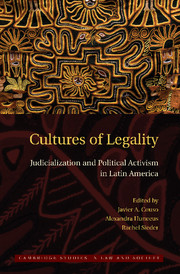Book contents
- Frontmatter
- Contents
- Contributors
- PART I INTRODUCTION
- PART II COURTS AND JUDICIALIZATION THROUGH A CULTURAL LENS
- 2 Legal Language and Social Change during Colombia's Economic Crisis
- 3 How Courts Work: Institutions, Culture, and the Brazilian Supremo Tribunal Federal
- 4 More Power, More Rights? The Supreme Court and Society in Mexico
- 5 Rejecting the Inter-American Court: Judicialization, National Courts, and Regional Human Rights
- PART III JUDICIALIZATION BEYOND THE COURTS
- Index
- CAMBRIDGE STUDIES IN LAW AND SOCIETY
- References
4 - More Power, More Rights? The Supreme Court and Society in Mexico
Published online by Cambridge University Press: 20 May 2010
- Frontmatter
- Contents
- Contributors
- PART I INTRODUCTION
- PART II COURTS AND JUDICIALIZATION THROUGH A CULTURAL LENS
- 2 Legal Language and Social Change during Colombia's Economic Crisis
- 3 How Courts Work: Institutions, Culture, and the Brazilian Supremo Tribunal Federal
- 4 More Power, More Rights? The Supreme Court and Society in Mexico
- 5 Rejecting the Inter-American Court: Judicialization, National Courts, and Regional Human Rights
- PART III JUDICIALIZATION BEYOND THE COURTS
- Index
- CAMBRIDGE STUDIES IN LAW AND SOCIETY
- References
Summary
INTRODUCTION
Under what conditions does an increase in the power of supreme courts to control other branches of government translate into greater protection of citizens' rights? In order to understand this process, we should consider not only the ability of the court to control the other branches, but also changes in the relationship between the court and the rest of the judiciary, and between the court and society. This chapter focuses on the case of Mexico, analyzing the interpretative framework developed by the Mexican Supreme Court on freedom of expression, freedom of association, and indigenous rights between 1988 and 2007.
A number of constitutional reforms after 1988, together with changes in the political and social context that modified the role of the Supreme Court in Mexican society, meant that the court became more politically powerful, more socially visible, and less omnipotent within the judiciary. The mandate of the high court to resolve conflicts between branches of government and to rule on the constitutionality or unconstitutionality of laws (judicial review) was strengthened. At the same time, the resolution of other cases, such as violations of citizens' individual rights, was progressively delegated to the appeals tribunals (Tribunales Colegiados de Circuito or TCC). Similarly, the power of the court to manage the judiciary was slowly curtailed though the creation of two key bodies: the Federal Council of the Judiciary (Consejo de la Judicatura Federal), created in 1994, and the Electoral Tribunal of the Federal Judiciary (Tribunal Electoral del Poder Judicial de la Federación), created in 1996.
- Type
- Chapter
- Information
- Cultures of LegalityJudicialization and Political Activism in Latin America, pp. 78 - 111Publisher: Cambridge University PressPrint publication year: 2010
References
- 8
- Cited by

